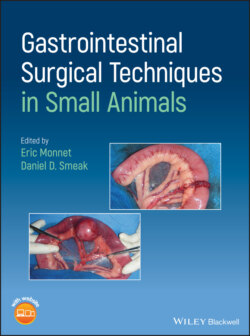Читать книгу Gastrointestinal Surgical Techniques in Small Animals - Группа авторов - Страница 42
3.2 Tissue Inversion, Eversion, or Apposition
ОглавлениеInverting suture patterns cause greater initial narrowing of the intestinal lumen (Bellenger 1982) but their main advantage is that these patterns provide more consistent initial leak‐proof closures (higher leak pressures). Everting patterns elicit greater adhesion formation to exposed mucosal edges, and provide the least leak‐proof closures, and therefore they are not currently recommended for gastrointestinal closure (Hamilton 1967). In theory, approximating (appositional) patterns accurately align tissue layers compared to inverting and everting patterns, and therefore, these patterns are now preferred for gastrointestinal closures. However, in practice, consistent tissue apposition with approximating suture patterns infrequently occurs when anastomoses were evaluated histologically. Nevertheless, direct apposition of all intestinal layers, particularly the submucosal layer, has been found to result in the most rapid direct bridging of the repair (Jansen et al. 1981).
